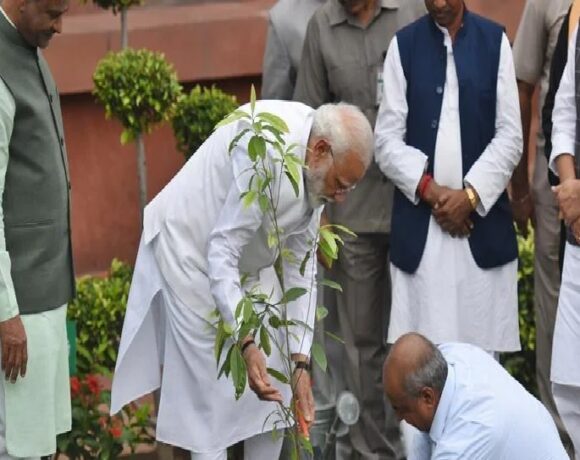

With India gearing up for rapid progress and all-round economic growth in the coming years and that too under a stable and development-oriented government, it undoubtedly seems to have the potential to emerge as the world’s next miracle economy. Emphasizing that the country is set to record a 7.4% growth in fiscal 2014-15, the latest Economic Survey foresees India’s GDP growth for 2015-16 hovering between 8.1% and 8.5%. It could even grow faster. The government report, compiled by Arvind Subramanian, a renowned development economist, has also asserted that the nation is on track to hit double digit growth rates in the coming years. Revealing that Asia’s third largest economy was building up growth momentum, the survey has affirmed that our country is set to emerge as the world’s fastest-growing big economy in the current year.
#Women #empowerment #WomensDay #IndiaLeadershipConclave2015 India Leadership Conclave 2015todebate Women Empowerment pic.twitter.com/T69alo4GxE
— Indian Affairs (@Indian_Affairs) August 20, 2015
India Leadership Conclave 2015 hosting its 6th edition in the commercial capital of Mumbai will be debating on a exclusive panel discussion on “Men and Women are equal-Choice brought Inequality”? to take stock of India’s journey since its independence at India@68. Joining the panel discussion will be top & successful empowered women leaders of the country such as Manisha Girotra, Chief Executive Officer, India, MOELIS & COMPANY. Meera Sanyal, Chairperson Urban Development Committee at Indian Merchants’ Chamber & Member of the National Committee on Economic Policy, Nisha JamVwal, Columnist, Luxury Brand Consultant, Interior Architect, Ajaita Shah, Founder/CEO, Frontier Markets Consulting Inc, Kiren Shrivastav, CEO, Molecule Communications, Tina Dehal, Tina Dehal Photography, Gul Pang, Actress, Activist & Politician, Morarji Nagma Arvind, Actress & Politician.
More than 50% of India’s current population is below the age of 25 and over 65% below the age of 35. About 72.2% of the population lives in villages.
Indian women make up half the country’s population, contribute to 70% of its working house and yet just earn 10% of India’s salary and a miserable 1% of its wealth. And it’s been 69 years since we got Independence. Yet, women are not given the freedom to be themselves, living their own life they dreamt about. Lets support the economic Independence of women and bring the real Independence. Live free and let live free.
“At the stroke of the midnight hour, when the world sleeps, India will awake to life and freedom. A moment comes, which comes but rarely in history, when we step out from the old to the new, when an age ends, and when the soul of a nation, long suppressed, finds utterance.” These were the ever famous words of the first Indian Prime Minister Jawaharlal Nehru, 68 years ago on August 15, as he spoke of India’s “tryst with destiny” and the time to “redeem our pledge”.
Indian fight for freedom was a much longer and painful than that of many other countries. Independence Day of India has a different meaning for different people of Indian origin living worldwide. It is an emotional and sensitive subject for many particularly the older (my) generation.
They would tell you about the sacrifices made by our ancestors and freedom fighters since 1856 to gain freedom from the British and you would also hear on the painful partition saga of 1947 when the Indian subcontinent was partitioned, India was split into two separate countries – the secular state of India, dominated by Hindus, and the Muslim state – Pakistan. You would hear how the British hastily and arbitrarily divided India along religious lines forcing the largest mass migration in human history while leaving behind their former colony. Millions of people were forced to leave their homes because of religious/ communal violence. Severe rioting and population movement ensued and an estimated half a million people were killed. About a million people were left homeless.
That was a time when our ancestors had fought for our existence and survival, our right to live with dignity and heads held high, our freedom where we create our own destiny.Let’s look at India today; how far the nation has come from 15th Aug 1947? With 1.27 billion population, of which 835 million can vote, today India is the world’s largest democracy and emerged as a major power in the 1990s. India is now considered as one of the most advanced countries in the world, it launches its own satellites and in 2008 sent its first spacecraft to the moon.
It is amongst the strongest in the world – militarily, has major cultural influence and a fast-growing and powerful economy which is projected to overtake the US as the world’s second largest economy by 2050 in PPP terms. India is now the largest Milk producer in the world, it was behind the European Union till last year but now with 132.4m tonnes production in 2014. According to International Monetary Fund director Christine Lagarde, India could outpace China as the world’s fastest growing economy as soon as this year. The country’s economy is expected to grow 7.5% in the upcoming 2015-2016 fiscal year, which begins in April, up from 7.2% in the current fiscal year. At that rate, India would be the world’s fastest growing large economy.
India is one of the world’s oldest civilizations, yet a very young nation. India is not a typical emerging market economy. It is a very specific talent market and Indian economy operates totally differently from any other emerging market or global growth economy. India is the solution to supply an aging world with a highly literate, English speaking and very driven young workforce.
More than half of India’s 1.25 billion population is below the age of 25, with 12 million Indians entering the workforce every year. The Indian Government and local industry is working on a target of skills development for 500 million Indians by 2022.With exponential growth also come challenges including social, law and order, economic and environmental problems. Be it first world or third world, it is no different than other countries in the world dealing with their own similar problems and turmoil. On comparison, a country of mammoth size like India that houses 1/6th of world’s population and a size of entire Europe may not be as alarming as being portrayed in today’s so-called social media by every Tom, Dick and Harry.Sweden now demographically resembles many third world countries, where having more men than women is the norm. This is the case in most of North Africa, the Middle East, China, and India. There being more women than men, by way of contrast, is normal across North America, Europe, Russia, South Africa and Australia.
India@68: Have we all forgotten sloganeering Women Empowerment – Reality Check
Women occupy only 9% of parliamentary seats less than 4% seats in High Courts and Supreme Court less than 3% administrators and managers are women.Close to 245 million Indian women lack the basic capability to read and write18 Adult literacy rates for ages 15 and above for the year 2000 were female 46.4% male rate of 69%19
Although efforts have been taken to improve the status of women, the constitutional dream of gender equality is miles away from becoming a reality. Even today, ‘the mainstream remains very much a malestream’. The dominant tendency has always been to confine women and women’s issues in the private domain. The traditional systems of control with its notion of ‘what is right and proper for women’ still reigns supreme and reinforces the use of violence as a means to punish its defiant female ‘offenders’ and their supporters. Hence it is of no surprise when the National Crime Records Bureau (NCRB) predicted that the growth rate of crimes against women would be higher than the population growth rate by 2010. To elucidate the subject, let us take a look at some government data, from the NCRB, 2002 and research done by some non governmental organisations. However it is important to mention here, the data presented here is only a partial reflection of the extent of crimes against women as most incidents of violence go unreported.
In a nation of more than 100 million woman, the notion of equal gender treatment is a hype if not a reality!
Women in India face myriad cultural challenges that impede social advancement, analysts say. Discriminatory family codes, lack of education, and cultural stigmas are only a few examples. Heightened media attention given to such inequities has raised pressure on the government to not just reform the institutional treatment of women, but also raise the level of dialogue on the larger issue of women’s rights in a rapidly modernizing society.
Gender Inequality
The Indian constitution prohibits discrimination on the basis of sex, but the position of women remains unequal, according to a United Nations report. Women in India have long been subject to entrenched cultural biases that perpetuate the valuing of sons over daughters, who are often seen as an economic burden to families that fear high dowries and wedding costs, experts say.
Sex-selective abortions have occurred at staggering rates in India despite a 1996 ban on screening for such purposes: researchers say up to six hundred thousand female fetuses are aborted in India every year, or 2.2 percent of the annual birth rate. This has tipped the gender ratio so dramatically that in 2011, there were 914 girls for every one thousand boys among children up to six years old—the most imbalanced gender ratio since India’s independence in 1947.
Researchers point to other significant factors contributing to the normalization of sex selection, including inheritance laws. The Hindu Succession Act of 2005 granted women equal inheritance rights to ancestral and jointly owned property, but enforcement of this law is weak, say experts. Many women, particularly in northern India, are still deprived of their rightful inheritance.
India’s Sexual Assault Laws
The December 2012 gang rape and subsequent death of a twenty-three-year-old student in New Delhi, ignited a national furor over India’s treatment of women and the perceived culture of complicity with regards to sexual violence in India. Such cases occur on a regular basis, says CFR Fellow for Women and Foreign Policy Rachel Vogelstein, but this incident drew particular attention due to a few uncommon circumstances, including the publication of the victim’s name and her father’s outspokenness. “The fact that she was a middle-class girl striving for a middle-class life really rang a chord with a lot of Indians,” says CFR Senior Fellow Isobel Coleman. “Here is a girl living a modern life and subjected to such barbaric treatment.”
Rape complaints increased 25 percent between 2006 and 2011 in India, although it is unclear whether this represents a real uptick in crime or a greater willingness by victims to file charges or by the police to accept them. However, gender-based violence as a whole has worsened in India over the past several years. National Crime Record Bureaustatistics show a 7.1 percent nationwide hike in crimes against women since 2010.
“It’s really a constellation of factors hindering women’s rights, including gender sex selection, literacy, child marriage, and violence.”–Rachel Vogelstein, Council on Foreign Relations
Under the Indian Penal Code, crimes against women include rape, kidnapping and abduction, molestation, sexual harassment, torture, homicide for dowry, and the importation of girls. But critics have voiced concern over the vagueness of their definitions, particularly that of rape. Often, perpetrators of severe sexual attacks are charged with criminal assault on a woman with “intent to outrage her modesty,” an offense that carries a light penalty and is rarely enforced.
“Eve-teasing,” a common euphemism for sexual harassment or molestation in public places, goes mostly unreported. Many analysts attribute this to a culture of complicity and the government’s weak prosecution of such assault crimes. A study by theHindustan Times found that in the last five years, fifty-one cases related to eve-teasing in the city of Jalandhar in Punjab were taken to court, and only five people were convicted, while thirty others were acquitted due to lack of evidence.
Searching for Justice
India’s slow, overburdened, and under-funded criminal justice system has exacerbated the plight of rape and sexual assault victims, analysts say. Most rapes go unreported, largely because of cultural stigmas surrounding such incidents that could bring shame to victims and their families. Those who do report cases often face a dehumanizing experience. A lack of specialized training for police and doctors often drives the problem, reports Human Rights Watch and other rights groups.
Furthermore, rights activists say, the lack of uniform national standards for the examination and treatment of sexual assault survivors undermines the potential for a successful prosecution. Only around 26 percent of rape cases tried in court in 2011resulted in convictions, and only four out of ten cases were reported, according to the National Crime Records Bureau, although these trends are not necessarily unique on a global scale. A study of forty acquitted rape cases in Delhi, where women comprise only seven percent of the police force, found that more than half of the acquittals were due to the police’s failure to perform sufficient investigations.
India’s slow, overburdened, and under-funded criminal justice system has exacerbated the plight of rape and sexual assault victims.
Still, some sexual assault victims face even worse injustice, as in the case of a seventeen-year-old village girl who was drugged and gang raped in northern Punjab in November 2012. She committed suicide after a police officer pressed her to drop the case and marry one of her attackers. Reports surfaced that officers had not only harassed the victim, but failed to register her case and attempted to broker an out-of-court settlement between her family and the families of her alleged attackers—a practice known locally as “compromise” that analysts say occurs often in some parts of the country.
Leniency in conviction and sentencing for juvenile offenders has also been cited as a recurring problem in the pursuit of justice for victims. This was highlighted in late August 2013 when India’s Juvenile Justice Board handed down a sentence of three yearsin a juvenile detention facility for one of six defendants in the Delhi bus rape that killed a twenty-three-year-old student. By contrast, the six men arrested over the gang rape of a Swiss tourist in March 2013 all received sentences of life imprisonment at their trial in July.
A Delhi court sparked further protests by acquitting in late August 2013 a twenty-two-year-old man from West Bengal accused of kidnapping and raping a fifteen-year-old girl whom he later married. The court ruled that consensual sex with minors was not punishable by the 2012 Protection of Children Against Sexual Offenses Act, which defines those under eighteen years of age as children.
Many rights activists have pointed to a pervasive culture of complicity when it comes to sexual violence against Indian women, charging that some senior political and religious leaders perpetuate the practice of “blaming the victim.” In June 2014, the home minister of central Chhattisgarh state said that rapes happen “accidentally,” renewing public outrage just days after another minister stated that rape was “sometimes right, sometimes wrong.” Violence against women is so lightly condemned that over the past five years, Indian political parties have nominated 260 candidates who have outstanding charges for crimes against women, according to Coleman.
“It’s really a constellation of factors hindering women’s rights, including sex selection, literacy, child marriage, and violence,” says CFR’s Vogelstein. “In addition to that, there’s been a culture of impunity around a lot of these issues. They have laws on the books that address all these issues, yet these problems continue to flourish in many parts of India.”
Political Representation
One of the major elements hampering women’s rights progress in India is the chronically low level of female political representation, analysts say. While Sonia Gandhi, the widow of former prime minister Rajiv Gandhi, presides over the Indian National Congress Party, only about 10 percent of parliament members are women. By contrast, women comprise 17 percent of the U.S. Congress, and in Pakistan, the National Assembly reserves 17.5 percent of its seats for women.
Progress on this front has been halting. In January 2012, India’s lower house delayed for at least a year a bill that would have reserved one-third of seats in Parliament and in state assemblies for women. The legislation was passed in the upper house in March 2010 after a thirteen-year debate. Once the amendment is ratified by the lower house, it still must be approved by at least half of the country’s state legislatures and the president—a process that will likely drag on for years and ensure that parliament, at least in the near term, will be dominated by men. To date, the bill is still pending.
Road to Reform
The national uproar in the aftermath of the Delhi gang rape prompted the Indian government to address calls for reform of the country’s judicial system. As provisional measures, Delhi ordered the use of so-called fast-track courts in several sexual assault cases in the capital, and established the first special court to handle crimes against women. The court, which opened in West Bengal in late January, is staffed and run entirely by women—a forum that officials hope will encourage more female victims to come forward. (In September 2013, the trial for the Delhi bus rape case ended in a guilty verdict and death sentences for four men charged with the crime. However, experts say an appeals process may drag on for some time.)
A breakthrough came in March 2013 when India’s parliament passed a new law further protecting women against sexual violence. The legislation criminalizes stalking, voyeurism, and sexual harassment, and imposes the death penalty on repeat offenders and for rape attacks that lead to the victim’s death. The law also makes it a crime for police officers to refuse reporting cases when victims file complaints of sexual attacks. The legislation came after Prime Minister Manmohan Singh set up a special committee in January 2013 that produced a 650-page reportof suggestions on how to strengthen criminal laws dealing with sexual assault against women. In June 2014, the new BJP-led government pledged “zero tolerance” for violence against women in response to the gang-rape and lynching of two lower-caste cousins in Uttar Pradesh.
Much of the work to improve conditions for women, however, is being done at the grassroots level, where some Indian and foreign nongovernmental organizations are engaging with the male community in an effort to elevate women in society. For instance, in Bihar state, a village planted mango and lychee trees to celebrate the birth of a girl, with the idea that profit from the fruit would help support the family and discourage the community from marrying off its daughters at young ages. Saba Ghori, a senior South Asia women’s issues adviser at the U.S. State Department, says the real gains in India have been at the local level, where women village leaders have been so effective that certain states have called for a greater percentage of women in such roles.
However, some analysts say the government’s actions have merely been a knee-jerk political expedient and will not materially improve much for women in the long run. “It’s a sort of Band-Aid,” says Coleman. “Laws alone aren’t going to change this. Not that laws aren’t important—they are—but we’re talking about social attitudes, cultural practices, and those don’t change overnight.”
This was evidenced in August 2013 when five men allegedly raped a twenty-two-year-old photojournalist in Mumbai, considered one of India’s safest cities for women, while on assignment for a magazine. The incident triggered sit-ins and protests, and will likely receive heightened scrutiny as reports revealed that two of the five accused could be minors and thus tried under India’s lenient Juvenile Justice Act.
Many rights groups say the government has more work to do, particularly because it failed to outlaw marital rape and handle the legal impunity afforded to members of the military. Still, other activists say the new measures, which imposed much stricter penalties for a range of crimes, mark some of the most significant progress in India’s laws protecting women.
“India is uniquely compelling because it’s a BRIC economy,” says Vogelstein. “India is emerging, and the degree to which women and girls are hampered in their ability to participate fully in their society and economies is going to be detrimental to the country’s modernization.”
In 90 per cent of urban Indian households, laundry is considered a woman’s job — not just for ensuring promotions at work for the husband, or an impromptu dance with the adoring slave-wife, as she puts out the tightie-whities to dry. Housewives almost always operate the washing machines…as many men, it appears, who so love the knobs and touch-screens of their cars and music systems, can’t figure out the dials of washing machines, and anyway who has the time to separate coloureds and whites and dainties. Perhaps a dirty secret of even first-world Western households…
New findings of Census 2011 released on Friday show that India is actually moving towards providing education to girl children. The findings show that there has been a rise in the level of women’s education between 2001 and 2011. The percentage of women seen passing out as graduates had risen to 116% and while that of women completing their post-graduation rose by 151% between the period. The increase in percentage of male graduates was only 65%.
In India, as in many parts of the world, a woman is considered to be a homemaker first. According to the World Economic Forum’s (WEF) Global Gender Gap Report 2014, Indian women spent an average of 352 minutes per day on unpaid work (men spent 52).
Sixty-two or 11% of the 543 elected members of parliament are women (our highest ever; still below the global average of 20%
there are far fewer women entrepreneurs than men: The WEF report says nine percent of Indian firms have female participation in ownership. Earlier data, from the Fourth All India Census of Micro, Small and Medium Enterprise sector (2006-07) (as summarised in the Annual Report 2014-15 of the ministry of micro, small and medium enterprises), says there were 26,60,000 ‘women enterprises’ (out of a total of 361,76,000), or around 7.3 percent of all MSMEs.
Gender bias, stereotyping and segmentation of duties are primary reasons for women comprising just 6.11 per cent of India’s police force, a latest report
Women voters have been increasing steadily in India since the 1960s or the 1970s
One year later, all major political parties said in their electoral campaigns that they were committed to the issue of “women’s safety.” So paternalistic, right? But at least urban women were being recognised as a vote bloc; a group that could swing the result if they were convinced you would (or wouldn’t) address their concerns. Who can forget how women overwhelmingly voted for Barack Obama in 2012?
There are ideas to be replicated from all over the world if we just look. Our National Commission of Women should take inspiration from their counterparts in the Philippines, Asia’s top performer on the annual Gender Gap Index of the World Economic Forum. The country has ranked in the top 10 since this index was constituted in 2006. On health and education indices especially, it’s difficult to compete with this island country.
It was revolutionary to hear an Indian prime minister talk about sex selection and foeticide from the ramparts of the Red Fort exactly one year ago. His Beti Bachao, Beti Padhaocampaign sounds great on paper. I hope it meets its main trackable goal: To improve the sex ratio at birth in 100 districts by 10 points in a year.
the prime minister, Ministers & Chief Ministers should forget about Twitter followers and Facebook campaigns for their landmark schemes and, instead concentrate on empowering them. They don’t need any special treatments, all they need is security, independent voice & gender indiscrimination
More than a million women in villages and districts have tasted power since 1992 when the constitution was amended to reserve 33% of seats (it was increased to 50% in 2009) in Panchayat Raj institutions for women.
One of 800 million: India has 800 million young men and women under the age of 35
While we celebrate 68 years of Independence, it is vital to truly understand what freedom means. A century ago, it meant doing away with British rule, an empire that made us unequals in our own country; where we were discriminated against on the basis of our skin colour and the place we were born. We had no rights against our masters and no recourse to get them. Plainly put, we weren’t free; free to be ourselves and live our lives the way we wanted. Today, our Constitution, the most sacred book of modern India, guarantees us a host of freedoms. Freedom to move about, speak, live anywhere, enter any place, work in whatever profession we want, think what we want — all in all, the freedom to be who we want to be. No more are we unequals in our own motherland. Today, we hold our heads up high and walk with pride, rejoicing in our still-new liberty .
But how far is that true? Are we really equals in all senses of the word? Are we all really free? Can we all move about when and where we want? Pursue any profession that we want? It is true that the establishment has no right to stop us and we can challenge it in the courts, which have been the protectors of our liberty, if it does. But what about the inequality inherent in our social fabric? What about the inequality every girl faces from the minute she takes her first breath? What about freedom from prejudice and social stratification? No girl in India is born free. In many cases, she is not even free to be born. If she is free in her house, then she is not free when she steps out of it. She cannot wear the clothes she chooses or go where she wants, when she wants. She is not free to feel safe in her own country. Men can roam the streets in the dead of night, but she has to be locked inside for fear for her safety. She is not free to pursue the career she wants because her family dictates what is most suitable given their plans for her. If she earns, she is not free to spend her money as she wants. Prior to marriage the terms are dictated by her family and after that, by her husband’s family. She is not free to marry who she wants because her marriage is not about her happiness, it is about the image of her family in society. She is not even free to decide if she wants to get married or not, let alone to choose when she is ready. She is not free to speak her mind or have opinions. If she has opinions, then she can’t express or act on them, for society sits in judgement over her words and actions and decides what is right for her. She is the one asked to stay home when the household has enough resources to only educate one child. Professionally, she has to work twice as hard to have access to the same opportunities as her male colleagues. If the family wants children, it is her career that is sacrificed. Bringing up a child is somehow always primarily her responsibility. There is hardly any equality in terms of household responsibilities. In a professional context, it is always the woman who is questioned as to how she will handle her family life when applying for a job. From the minute she is born, a woman faces some sort of discrimination. The saddest part of this discrimination and oppression is that many women today have so internalised this that they refuse to recognise it or realise it even exists. They have justified this treatment as natural. They do not protest when it happens to them. They still feel, deep down, that men are more capable. In which case, they become satisfied with taking a backseat or expect second place from the start. It is time each member of society recognised that capability is individual, and cannot be judged in terms of gender. It is up to us to explore our boundaries. As we celebrate this 68th year of our Independence, we need to look towards a free society for each of our citizens. If nearly half of our population has been living in such oppression, how can we call ourselves free? We need to create a nation free from fear, oppression, discrimination and prejudice. A free India where every Indian has the same choices and opportunities as the rest is the only India that can signify the pinnacle of development we desire
GIVE THEM THE CHOICE THAT WE ALL HAVE
On the 69th year of Independence, while India celebrates with pompadour and selfies, I feel a twinge of dissatisfaction with my apparent freedom. As an independent woman in urban India, I am supposed to be privileged and doing exactly what I want. That’s what freedom bought us; a democracy with assured constitutional rights. However, I still crave freedom from multiple things in India that does not come easy to a woman.
What do we need freedom from, you ask? Well, let’s chalk out a list.
Freedom to wear anything
Yes. We have talked about this and we will continue to till we really have the freedom to wear anything. We will talk about this till we are free from catcalls and whistles if we wear a low cut blouse. Women rethink their wardrobe choices each time they go out. I need freedom from judgement, perversion, voyeurism and just the feeling of being unsafe in my own country. Freedom to go anywhere
Every woman, even ones who live on their own, have a curfew whether we talk about it or not. We do not walk down lanes alone at night. We don’t take Ubers alone if it’s beyond a certain time. We need male escorts when going to clubs at night. We walk with our bags in front of us in areas we don’t feel safe. We choose restaurants according to crowds, and movie theatres as well. We have concerned parents and friends and boyfriends to answer to. We have moral policemen/women to stand up to.
Freedom from sexual harassment
Women are afraid of sexual harassment— on public transport, on the road, at workplace, even in a relationship. Women walk with tension in their body language, looking out for danger all the time. Why should assault be a natural part of every woman’s life in India?
Freedom from the inevitability of motherhood
Every little girl is told about how they will get married and be a mother some day. They are never even given a choice. Motherhood needs to be treated as a choice and not an eventuality in India. Infertility needs to be not treated as a crime or a reason for shame. Not all women see children in their future. Women do not need to be reminded of their biological clock.
Freedom from judgement if we have a sex life
Contrary to popular belief, women have libidos, they like sex as much as men, and they watch adult cinema. I can almost hear the cumulative gasp at this statement. However, women need freedom from this judgement. Women are free to have sexual partners who are not their boyfriends or their husbands. Virginity needs to stop being a yardstick for judging women. India, wake up and smell the female ejaculation.
Freedom from sexism at workplace
Recently, a friend of mine who works at a car manufacturing giant, was told “girls who talk cars don’t look like you”. The ‘look’ that was talked about was beautiful, slim and well kept, not considering that my friend also has a mechanical engineering degree and eight years of work experience. This is just a random example of sexism at workplace. Sexual harassment, absurd appraisals and objectification are just a few things we need freedom from at the workplace.
Freedom to do any job
Women still can’t serve at an active war front. They can’t be recruited to border security force. Women can’t work night shifts at manufacturing plants. Could we please stop being restricted for our “safety”?
Freedom from abusive trolls online
Part of the experience of being a social being on social media is handling trolls. For women, the price of participating in a healthy debate might often be a rape threat online. While men get verbal abuses, women receive rape threats and comments about their looks and make-up.
Freedom from the burden of honour
Women in India carry the burden of their family’s honour wherever they go. Apparently the family’s honour is linked with their bodies and their vaginas. Women need freedom from being caretakers of this imaginary honour. Our family’s or community’s honour cannot be tied to the kind of jobs we have, the clothes we wear, the person we marry or the life we lead.
In India, women comprise about 30 percent of corporate senior management positions, which is notably higher than the global average (24 percent). But in the overall workforce, India is one of the worst countries in the world — 113th out of 135 — when it comes to the gender gap. And women entrepreneurs constitute only 10 percent of the total number of entrepreneurs in the country.
We believe that women entrepreneurs have an edge over male entrepreneurs. Edges matter to investors. And the numbers back this up outside India. I believe that this is also true in India.
One of the most obvious reasons to invest in women leaders in India is that women control the vast majority of household spending. So unless you are a business that is focussed mostly on men, women are more likely to better understand customer perspective. Another is that women are often better at building long-term relationships than men. Lasting relationships benefit a business tremendously, as only so much can be achieved without trust… with employees, customers, suppliers, shareholders, government, etc.
There is also the factor of having diversity in a leadership team. Multiple studies, including Kellogg’s Better Decisions Through Diversity, argue that “socially different group members do more than simply introduce new viewpoints or approaches… diverse groups outperformed more homogeneous groups not because of an influx of new ideas, but because diversity triggered more careful information processing that is absent in homogeneous groups”. In a world of information overload, having better information analysis capacity and doing smarter things with the information you have will provide a competitive edge.
A Dow Jones study called Women at the Wheel: Do Female Executives Drive Startup Success? offers some interesting conclusions:
- The overall median proportion of female executives in successful companies is 7.1 percent, compared to 3.1 percent at unsuccessful companies.
- A company’s odds of success increase with female executives at the VP and director levels.
- Statistically significant evidence shows that there is dependence between a company having female executives and its success.
For startups with more female executives, there is a higher success-to-failure rate. As you can see in the chart below, companies with 1-2 female executives have close to a 50/50 failure/success rate, with failures exceeding successes by 5-10 percent. But in the smaller samples of companies with 4-5 female
The challenge will be where to find them. According to the Economic Times, as of 2012, women students at IITs had almost doubled to 11 percent in five years and their numbers at two B-schools – ISB-Hyderabad (29 percent) and IIM-Kozhikode (36 percent) – were inching closer to Harvard Business School (39 percent). Other IIMs are lagging though. IIM-Calcutta has only seven percent women in the class of 2013 and IIM-Ahmedabad only 10.9 percent.
Role models are vital for encouraging more women into technical and business universities as well as to entrepreneurship. Author Rashmi Bansal recently published “Follow Every Rainbow: Inspiring Stories of 25 Women Entrepreneurs whose Gentle Touch Created Strong Businesses.” I’m hopeful that more broadly read stories of successful women will provide encouragement to attract more to the field. We are on the lookout for exceptional women entrepreneurs. And other smart VCs are too.


















